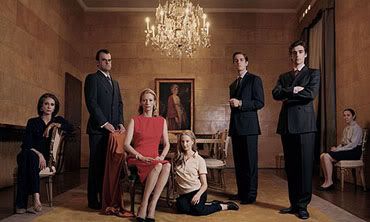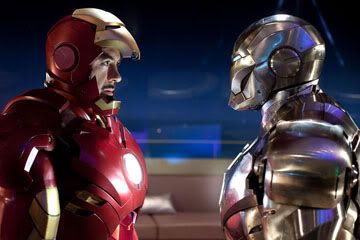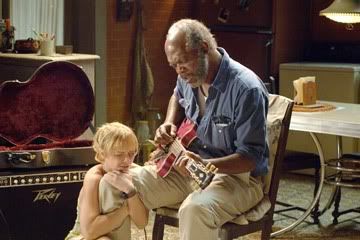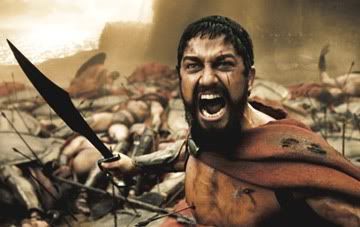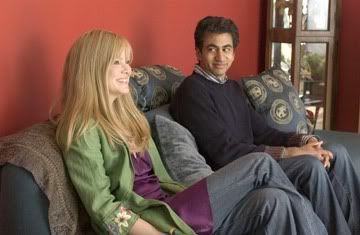
 Archive: "Grindhouse" (2007)
Archive: "Grindhouse" (2007)A grindhouse from the 70s was a theater that specialized in showing dirty exploitation flicks; these are the types of movies that are low-budget, poorly written, and include as much violence and sex as possible. These films laugh in the face of plot and characters and present only visceral thrills with immediate shock value with over-the-top outrageousness. So, here we are in the year 2007 and being taken to an evening at a grindhouse thanks to two of the most famously violent and acclaimed directors of our time. It is a double feature including Robert Rodriguez's "Planet Terror" and Quentin Tarantino's "Death Proof." It's obvious that these two directors were huge fans of grindhouses; they don't parody the idea but instead pay massive tribute to it. They're not being ironic or mocking themselves or the inspiration behind grindhouses; they're celebrating it, and through that, they're also celebrating the sheer joy of going to the movies. This is one night out to the movies that you will remember for a long time. It's like nothing you have ever seen before in theaters nowadays, and it should not be missed.
Rodriguez's "Planet Terror" is the first and main feature of the double presentation. The movie opens with a woman go-go dancing on a pole with a provocative and extremely catchy theme song pumping in the background. The camera follows her every curve, her every sway, and her every thrust. It is later discovered that this woman's name is Cherry (Rose McGowan) and that she should have been appreciating those two perfect legs of her more than she was. At a sleazy barbecue joint owned by a man named JT, she meets up with her rough-and-tumble ex-boyfriend, Wray (Freddy Rodriguez). Together on the road they get attacked by a zombie that tears Cherry's leg clear off, hence her lack of appreciation for it before. Meanwhile, at a nearby hospital, a woman nurse introduces her three anesthetic needles to a patient; they're her yellow, blue, and red friends. Her husband, who is also a doctor, finds out that his wife has been committing adultery with another woman, and soon the nurse isn't getting such good treatment from her little friends.
Cases of infected people start pouring into the hospital, and Rodriguez doesn't hesitate to show the most horrendous and gory wounds you've ever seen; it's some really sick stuff. Soon, the outbreak gets bad enough that pretty much every single main character introduced all band together to take down the growing mass of zombies. JT from the barbecue shack, the nurse who escaped the wrath of her husband, the nurse's bitchy teenage babysitters, and a few sheriffs from town all team together for an explosive blow-out of a climax. The chaos gets so over-the-top to the point that Cherry's automatic rifle prosthetic leg could not be seen as anything less than that.
Guns go blazing, and heads explode not just off but actually apart as to show fragments of face just sitting there. Zombies eat people's insides and there are close-ups of the act, and blood sprays across the screen with such thick, bright redness that you would swear it is slime. The zombies are dripping with oozing puss and disturbing growths, and they're frankly the coolest zombies I've seen in a movie. Although "Planet Terror" is basically the sole reason for the movie's explicit violence, it's still all in good fun; everything is so overblown and over-the-top that you don't scream when somebody's limb gets ripped off, but rather, you chuckle and laugh. Rodriguez's violent zombie fest is a celebration of campy violence, and this becomes clear when the nurse tells her young son to shoot a gun just like he does in his video games. This is a film where when somebody says "no-brainer," they mean it literally. The entire ordeal is gross, graphic, sick, disgusting, and ready to kick some serious ass; and so it does. Extensively.
Before and after the first feature film, we're shown trailers of fake coming attractions that really are exploitation whoppers. With titles such as "Machete," "Thanksgiving" (a parody on "Halloween"), and "Werewolf Women of the SS," you really cannot go wrong. These trailers are absolutely, flat-out hilarious and worth the price of admission alone. The trailers are directed by real-life directors such as Eli Roth and Rob Zombie, which is coincidental because there were previews for their films during the real previews. There's even a fake advertisement for a restaurant next door to the theater, and you'll see characters within both films drinking the pop that was advertised. Great cameos are plentiful in both the trailers and the feature-length movies, including Nicholas Cage, Bruce Willis, and Quentin Tarantino himself, who shows up in both films.
The two feature films are entirely different, yes, but they also have their connections. For example, the nurse you see in "Planet Terror" shows up early on in "Death Proof." Both movies at first seem to take place sometime in the 70s, and thus being shown in a style that seems from the 70s. Upon further investigation, however, you'll soon notice that both features actually take place in the present. In "Planet Terror" there is a reference to the war in Iraq, in "Death Proof" a car blasts through a movie theater sign presenting "Scary Movie 4," and in both movies the characters all use cell phones.
Both of these movies are meant to look and sound like crap, and become wonderfully artistic and stylish in doing so. Both films are shakily projected, and there are crackles in the screen, pops and fizzles in the audio, and fake scratches and tears in the film reel. In even a few cases, entire reels of film "go missing" and we're given a short moment of apology for the inconvenience. In a could-be steamy sex scene during "Planet Terror," the film reel heats up too much and literally melts away from the screen, thus ending the sex immediately and skipping to the next scene. It's this type of authentic 70s touch that makes the entire experience feel genuine and all the more fun. It brings back the joy and excitement and exhilaration of going to the movies all over again.
Quentin Tarantino's "Death Proof" is not nearly as violent or gory as "Planet Terror," but it's equally enjoyable and over-the-top. Tarantino's style of characterization and long segments of dialogue are all there and accounted for. You'll overhear conversations that are reminiscent of even "Pulp Fiction." Although obviously not to that level, even when he's not at the top of his game, he's still damn good and knows how to infuse dark humor into every scene. And remember, it's still meant to be campy and bad, but surprisingly, it does comes off less so than Rodriguez's flick with less film distortion than the other. The story at first follows a group of high, drunken women just looking for a good time; it's a time that doesn't end too well thanks to a man who calls himself Stuntman Mike (Kurt Russell).
This man takes a woman named Pam home in his muscle car. Now, before I go any further, let me say that Rose McGowan also plays Pam, a much different character than Cherry from "Planet Terror"; however, it is definitely her seductive performance as Cherry that really takes the win. Anyway, this Stuntman Mike uses his car as a homicide weapon against young women such as Pam. Later on, he tracks down yet another group of women including actress Rosario Dawson playing the character of Abernathy. The star here, though, playing herself in this role, is actually the woman who apparently was a stunt-double for Uma Thurman in "Kill Bill," Zoe Bell. She gets on the roof of a car and barrels down the street with her two friends just for the hell of it. Unexpectedly, however, here comes Stuntman Mike, plowing his muscle car into the side of them, shoving Zoe nearly off the hood.
What ensues is the one of the most exhilarating car chase sequences I've actually ever seen in a movie, and it's especially cool to be coming from a movie such as this. Soon enough, the women escape Mike's clutches and dish out their revenge on him. Kurt Russell gives a multi-faceted but small performance here as he shows his dark, sinister side along with his hysterical frenzied side when he realizes now he's the one being pursued. The women finally catch him and give him the beating of his life; with hip 70s music pumping in the background, this over-three-hour experience ends with a literal kick, as Rosario Dawson takes her high-heeled boot and smashes it into Kurt Russell's face. And roll credits.
"Grindhouse" brings back the reason why people enjoy the act of going to the movies in the first place. It's so we can interact with each other through laughing at the absurd lack of story, cringing at the disgusting gross-out moments, and yelling when zombies get killed with a massive spray of blood. What Quentin Tarantino and Robert Rodriguez have brought to the screen this weekend is like nothing ever conceived, or at least not since the 70s. It's destined to be a cult classic because it already has the look and feel of one anyway. Even though it's definitely not something for everybody, and even though it lacks any human emotion or morality whatsoever, this is brilliant film making at work and a masterpiece of schlock. Going to see this film isn't simply going to see one movie; this is an event. For the price of admission, you are getting two feature length films, along with trailers and advertisements, and with no intermission; once you're in, you better settle in for good. I don't care what other people say; this is the best movie of the year so far and by far.




